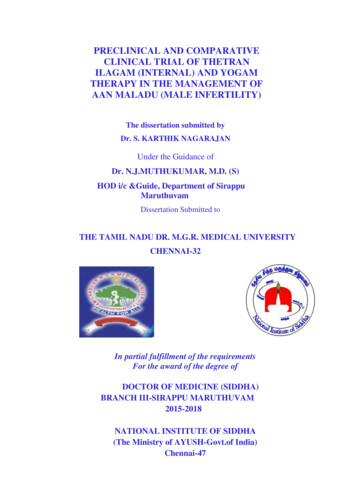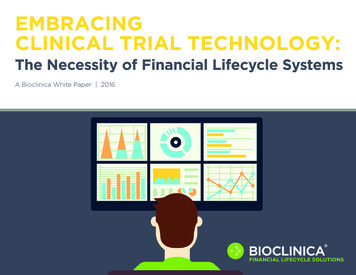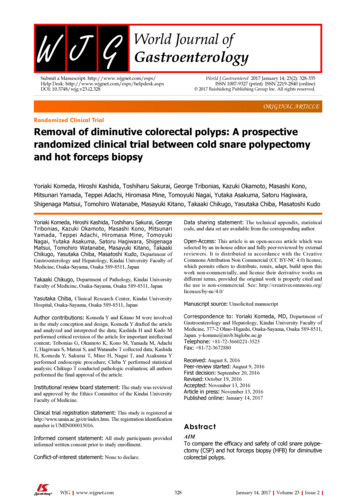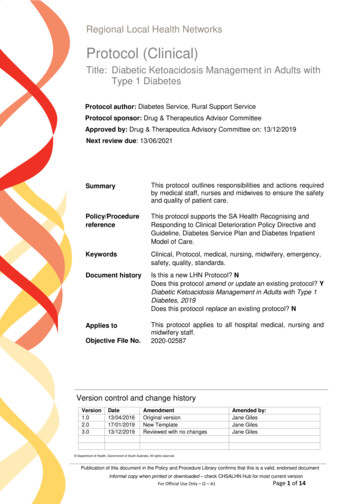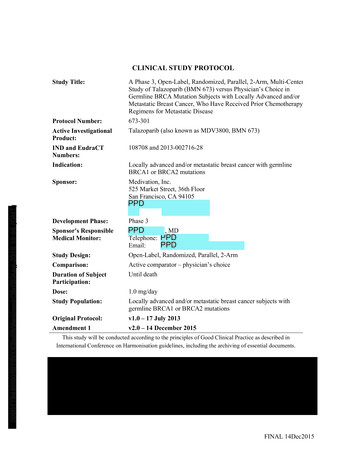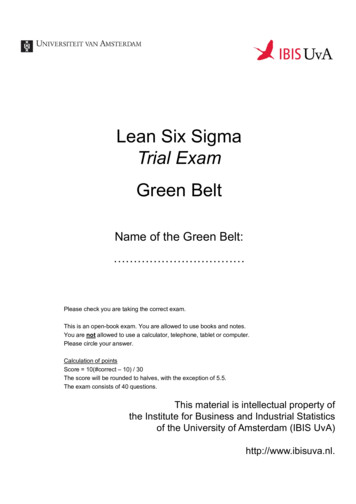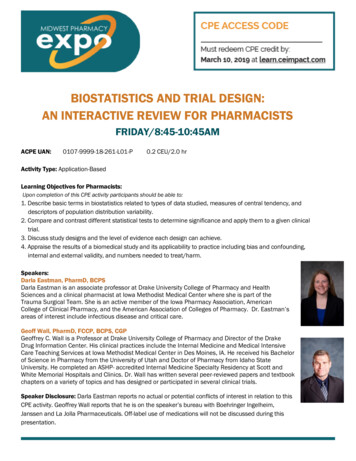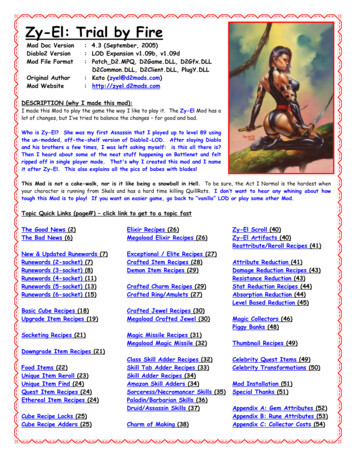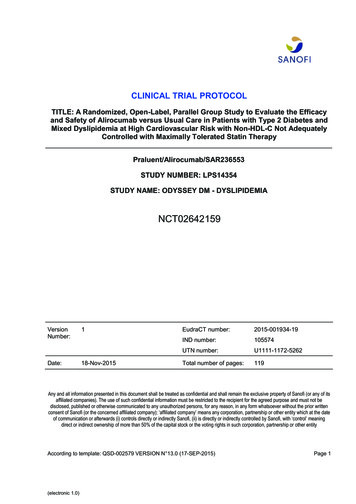
Transcription
CLINICAL TRIAL PROTOCOLTITLE: A Randomized, Open-Label, Parallel Group Study to Evaluate the Efficacyand Safety of Alirocumab versus Usual Care in Patients with Type 2 Diabetes andMixed Dyslipidemia at High Cardiovascular Risk with Non-HDL-C Not AdequatelyControlled with Maximally Tolerated Statin TherapyPraluent/Alirocumab/SAR236553STUDY NUMBER: LPS14354STUDY NAME: ODYSSEY DM - DYSLIPIDEMIA1&7 VersionNumber:Date:118-Nov-2015EudraCT number:2015-001934-19IND number:105574UTN number:U1111-1172-5262Total number of pages:119Any and all information presented in this document shall be treated as confidential and shall remain the exclusive property of Sanofi (or any of itsaffiliated companies). The use of such confidential information must be restricted to the recipient for the agreed purpose and must not bedisclosed, published or otherwise communicated to any unauthorized persons, for any reason, in any form whatsoever without the prior writtenconsent of Sanofi (or the concerned affiliated company); ‘affiliated company’ means any corporation, partnership or other entity which at the dateof communication or afterwards (i) controls directly or indirectly Sanofi, (ii) is directly or indirectly controlled by Sanofi, with ‘control’ meaningdirect or indirect ownership of more than 50% of the capital stock or the voting rights in such corporation, partnership or other entityAccording to template: QSD-002579 VERSION N 13.0 (17-SEP-2015)HOHFWURQLF Page 1
Clinical Trial ProtocolSAR236553-LPS14354 - alirocumab18-Nov-2015Version number: 1NAMES AND ADDRESSES OFCOORDINATINGINVESTIGATOR Name:Address:Tel:Fax:E-mail:MONITORING Company:Address:SPONSOROTHER EMERGENCYTELEPHONE NUMBERSProperty of the Sanofi Group - strictly confidentialHOHFWURQLF Page 2
Clinical Trial ProtocolSAR236553-LPS14354 - alirocumab18-Nov-2015Version number: 1CLINICAL TRIAL SUMMARYCOMPOUND: SAR236553 (Praluent/Alirocumab)STUDY No: LPS14354STUDY NAME: ODYSSEY DM-DyslipidemiaTITLEA Randomized, Open-Label, Parallel Group Study to Evaluate the Efficacyand Safety of Alirocumab versus Usual Care in Patients with Type 2 Diabetesand Mixed Dyslipidemia at High Cardiovascular Risk with Non-HDL-C NotAdequately Controlled with Maximally Tolerated Statin TherapyINVESTIGATOR/TRIAL LOCATIONMultinational-MulticenterPHASE OF DEVELOPMENT3b/4STUDY OBJECTIVE(S)Primary objective:xTo demonstrate the superiority of alirocumab in comparison withusual care in the reduction of non-high-density lipoproteincholesterol (non-HDL-C) after 24 weeks of treatment in patients withType 2 diabetes and mixed dyslipidemia at high cardiovascular (CV)risk with non-HDL-C not adequately controlled with maximallytolerated statin therapy.Secondary objective(s):xTo demonstrate whether alirocumab is superior in comparison withusual care in its effects on other lipid parameters at Weeks 12and 24 (ie, low-density lipoprotein cholesterol (LDL-C),apolipoprotein B (Apo B), total cholesterol (Total -C), lipoprotein a(Lp[a]), high-density lipoprotein cholesterol (HDL-C), triglycerides(TGs), triglyceride rich lipoproteins (TGRLs), apolipoprotein A-1(Apo A-1), apolipoprotein C-III (Apo C-III), lipid subfractions bynuclear magnetic resonance (NMR) spectroscopy (ie, LDL particlesize and LDL, very low-density lipoprotein (VLDL), HDL,intermediate-density lipoprotein (IDL) particle number)xTo demonstrate the superiority of alirocumab in comparison withusual care in the reduction of non-HDL-C at Week 12.xTo assess changes in diabetes related parameters in patientsrandomized to alirocumab vs. usual care treatment over a period of24 weeksxTo demonstrate the safety and tolerability of alirocumabxSTUDY DESIGNxTo evaluate changes in proprotein convertase subtilisin kexin type 9(PCSK9) concentrations at Weeks 12 and 24xTo evaluate the development of anti-alirocumab antibodiesxTo demonstrate the superiority of alirocumab versus fenofibratetherapy on non-HDL-C and other lipid parametersThis is a Phase 3b/4 randomized, open-label, parallel group study to assessthe efficacy and safety of alirocumab administered by subcutaneous (SC)injection versus usual care in patients with Type 2 diabetes and mixeddyslipidemia at high CV risk with non-HDL-C not adequately controlled withmaximally tolerated statin therapy.Patients will be taking a stable, maximum dose/regimen of statin that isProperty of the Sanofi Group - strictly confidentialHOHFWURQLF Page 3
Clinical Trial ProtocolSAR236553-LPS14354 - alirocumab18-Nov-2015Version number: 1tolerated by the patient without other lipid modifying therapies at baseline.Patients may be on no statin if unable to tolerate statin therapy as judged bythe investigator.Randomization will be unbalanced (2:1, alirocumab:usual care). The study willbe a multinational, multicenter study. Usual care includes the option to continue on the maximum dose of statin thatis tolerated by the patient without the addition of a new lipid modifying therapy(LMT) at randomization, or the initiation of either ezetimibe, fenofibrate,omega-3 fatty acids, or nicotinic acid at randomization for the remainder of the24-week treatment period. Initiation of usual care treatment investigationalmedicinal product (IMP) should start as soon as possible after randomization,but no later than 7 days from the day of randomization.The Investigator will select the most appropriate LMT for the patient prior torandomization (consisting of either no additional LMT but continuing onmaximum tolerated statin, ezetimibe, fenofibrate, omega-3 fatty acids ornicotinic acid) and enter this information into the interactive voice responsesystem (IVRS). If the patient is randomized to open label alirocumab, theInvestigator will not institute the LMT option that was selected and enteredinto IVRS but instead treat the patient with open label alirocumab. If thepatient is randomized to usual care (non-alirocumab), the Investigator willinitiate treatment with the LMT option that was selected and entered intoIVRS, as applicable, in addition to continuing the patient on the maximumtolerated dose of statin.Randomization will be stratified by the Investigator’s selection of usual caretherapy prior to randomization (for example, the intent to prescribefenofibrate, intent to prescribe ezetimibe, etc). This will help ensure balancedtreatment groups with patients’ characteristics as homogenous as possible.Recruitment of patients will complete when 420 patients have beenrandomized.Patients randomized to open label alirocumab will continue on the maximumdose of statin that is tolerated by the patient and will administer alirocumabSC with a starting dose of 75 mg every 2 weeks (Q2W) for 12 weeks with ablinded uptitration to alirocumab 150 mg Q2W at week 12 if the non-HDL-C atthe week 8 visit is 100 mg/dL (2.59 mmol/L). Patients who have a nonHDL-C 100 mg/dL (2.59 mmol/L) at the Week 8 visit will continue withalirocumab 75 mg Q2W until the end of the treatment period.No changes during the course of the study will be made to the dose of LMTadministered as part of the usual care arm except for nicotinic acid for whichthe Investigator may prescribe at randomization a scheduled/gradual dosetitration in order to allow for the maximum dose to be achieved based onpatient tolerability or except if needed for any usual care LMT for the safety ofthe patient, based on the Investigator’s judgment.The study consists of:xA screening period of up to 3 weeks;xAn open-label treatment period (OLTP) of 24 weeks;x A safety observation period of 8 weeks.A phone visit will take place at Week 32 in order to document any adverseevent(s) that might occur between Weeks 24 to 32.Patients should have been previously instructed on a cholesterol lowering dietprior to screening. During the study, the Investigator may reinforce dietProperty of the Sanofi Group - strictly confidentialHOHFWURQLF Page 4
Clinical Trial ProtocolSAR236553-LPS14354 - alirocumab18-Nov-2015Version number: 1recommendations according to local/regional guidelines. Patients should bereceiving antihyperglycemic treatment in accordance with local/ regionalstandards of care. Changes to antihyperglycemics should be limited andmade only in circumstances where it is clinically needed. Statin dose and dose regimen should be stable throughout the entire studyduration including for 4 weeks prior to the screening period and fromscreening to the end of the open label treatment period.The data on lipid parameters from blood samples will be masked afterrandomization. No attempts should be made by the Investigator or patient tohave the patient’s lipid values independently evaluated after randomizationuntil after the Week 24 visit, except for the safety of the patient as per theInvestigator’s judgment. At the end of the OLTP (Week 24 visit), theInvestigator will continue to manage the patient’s lipids in accordance withstandard practice. Any lipid values after randomization (eg, if done for patientsafety) should be redacted in the source documents and not shared with theSponsor.Duration of study treatment will be 24 weeks with the last injection of openlabel alirocumab administered at Week 22. The treatments prescribed in theusual care arm will be administered for 24 weeks. From the Week 24 visitonward, the Investigator will continue to manage the patient’s lipids inaccordance with standard practice.Patients will visit the study site at Weeks -3, 0, 8, 12, 20, and 24 with lab workat each visit; in addition a phone visit is scheduled at Weeks 4 and 32.Week 8 is a critical visit because it will be the only scheduled visit where anon-HDL-C value for uptitration will be available.STUDY POPULATIONInclusion criteria:Main selection criteriaI 01.Patients with Type 2 diabetes and mixed dyslipidemia notadequately controlled with a stable, maximum dose/regimen ofstatin that is tolerated by the patient* for at least 4 weeks prior to thescreening visit (Week -3) without other LMT.*Note: The maximum dose/regimen of statin that is tolerated by the patient isthe highest registered dose/regimen tolerated by the patient based on thejudgment of the Investigator. Patients not able to be on a maximumdose/regimen of statin should be treated with the dose of statin which isconsidered appropriate for the patient as per the Investigator’s judgment orconcerns. Some examples of acceptable reasons for a patient taking a lowerstatin dose include, but are not limited to: adverse effects on higher doses,advanced age, low body mass index (BMI), regional practices, localprescribing information, concomitant medications. Patients may be onalternate day dosing of statin as long as the dose is consistently taken (eg,dose every Monday, Wednesday, Friday, etc). Concomitant treatment withmore than 1 statin is not permitted. Patients who have documented statinintolerance, as judged by the Investigator, and who are no longer on statintherapy as a result will also be eligible for the study. The reason(s) for notbeing on a maximum dose/regimen of statin (including statin intolerance) willneed to be documented in the case report form.I 02.I 03.Patients 18 years of age or legal age of majority at screening visitwhichever is greater.Documented history of atherosclerotic cardiovascular disease(ASCVD) or at least one additional CV risk factor.Notes:Property of the Sanofi Group - strictly confidentialHOHFWURQLF Page 5
Clinical Trial ProtocolSAR236553-LPS14354 - alirocumab18-Nov-2015Version number: 1Atherosclerotic cardiovascular disease (ASCVD) includes: coronary heartdisease (CHD) and CHD risk equivalents (PAD, ischemic stroke)History of CHD includes at least one of the following: xacute myocardial infarction (MI),xsilent MI,xunstable angina,xcoronary revascularization procedure (eg, percutaneous coronaryintervention [PCI] or coronary artery bypass graft surgery [CABG])xclinically significant CHD diagnosed by invasive or noninvasivetesting (such as coronary angiography, stress test using treadmill,stress echocardiography, or nuclear imaging).CHD risk equivalents include at least one of the following:xDocumented peripheral arterial disease (PAD) (one of the followingcriteria [a, b, or c] must be satisfied):a) Current intermittent claudication (muscle discomfort in thelower limb that is both reproducible and produced by exerciseand relieved by rest within 10 minutes) of presumedatherosclerotic origin TOGETHER WITH ankle-brachial index 0.90 in either leg at rest, ORb) History of intermittent claudication (muscle discomfort in thelower limb that is both reproducible and produced by exerciseand relieved by rest within 10 minutes) TOGETHER WITHendovascular procedure or surgical intervention in one or bothlegs because of atherosclerotic disease ORc) History of critical limb ischemia TOGETHER WITHthrombolysis, endovascular procedure or surgical interventionin one or both legs because of atherosclerotic disease.xDocumented previous ischemic stroke with a focal ischemicneurological deficit that persisted more than 24 hours, consideredas being of atherothrombotic origin. Computed tomography ormagnetic resonance imaging must have been performed to rule outhemorrhage and non-ischemic neurological disease.Cardiovascular risk factors include at least one of the following:xI 04.I 05.Property of the Sanofi Group - strictly confidentialHOHFWURQLF hypertension (established on antihypertensive medicine)xcurrent cigarette smokerxage 45 years for men and 55 years for womenxhistory of micro/macroalbuminuriaxhistory of diabetic retinopathy (preproliferative or proliferative)xfamily history of premature CHD (in father or brother before55 years of age; in mother or sister before 65 years of age)xlow HDL-C (male 40 mg/dL [1.0 mmol/L] and female 50 mg/dL[1.3 mmol/L])xdocumented chronic kidney disease (CKD) as defined by15 estimated glomerular filtration rate (eGFR) 60 mL/min/1.73 m2for 3 months or more, including the screening visit).Non-HDL-C at screening 100 mg/dL (2.59 mmol/L).Triglycerides at the screening visit 150 mg/dL (1.70 mmol/L) andPage 6
Clinical Trial ProtocolSAR236553-LPS14354 - alirocumab18-Nov-2015Version number: 1 500 mg/dL (5.65 mmol/L).Stable anti-hyperglycemic agents for at least 3 months prior to thescreening visit and between screening and randomization (includingstable insulin dose defined as no variation more than 30% in dailyinsulin dose within the preceding 3 months, as judged by theInvestigator).I 07.No variation of weight more than 5 kg within 3 months prior to thescreening visit or between screening and randomization, as judgedby the Investigator.I 08.On stable dose of medications that are known to influence weightand/or lipids (other than LMTs) within 3 months prior to thescreening visit or during the screening period (eg, estrogenreplacement, oral steroids, antipsychotics known to impact weight).I 09.Signed written informed consent.Exclusion criteria:I 06. Total expected number of patientsxUse of any LMTs other than statins within 4 weeks prior to thescreening visit or during the screening period (eg, ezetimibe,fenofibrate, nicotinic acid, omega-3 fatty acids, etc) or use of overthe counter products/nutraceuticals known to impact lipids (eg, redyeast rice) within 4 weeks prior to the screening visit or during thescreening period.xCurrently drinking more than 2 standard alcoholic drinks/day (Note:A standard drink is considered as 1 pint/bottle of beer, 1 glass ofwine, or 1 shot of hard liquor).xBody Mass Index (BMI) 45 kg/m2 at screening or currently enrolledin a weight loss program and still in active phase of weight loss, asjudged by Investigator.xHbA1c at screening 9%A total of 420 patients are expected ( 280 patients will be randomized toalirocumab and 140 randomized to usual care).STUDY TREATMENT(s)Investigational medicinalproduct(s)Alirocumab (open label).Formulation:Prefilled pen; Sterile alirocumab drug product supplied at a concentration of75 mg/mL or 150 mg/mL in histidine, pH 6.0, polysorbate 20, and sucrose.Route(s) of administration:Subcutaneous (SC); 1 injection of 1 mL SC in the abdomen, thigh, or outerarea of upper arm (ie, deltoid region)Dose regimen:Alirocumab 75 mg Q2W with possible uptitration at Week 12 to 150 mg Q2W.The last planned injection of alirocumab IMP is to be administered atWeek 22.Note: A placebo injection for training purposes will be administered to thepatient at screening, with the option of a second training injection prior torandomization. If the person who is designated to administer alirocumab tothe patient changes during the course of the study, the new designatedperson will be trained with a placebo.Investigational medicinalproduct(s)Usual Care (open label).There are five options available in the usual care arm including the option toProperty of the Sanofi Group - strictly confidentialHOHFWURQLF Page 7
Clinical Trial ProtocolSAR236553-LPS14354 - alirocumab18-Nov-2015Version number: 1add no additional LMT on top of the maximum dose/regimen of statin that istolerated by the patient or to start one of the following treatments: ezetimibe,fenofibrate, omega-3 fatty acids or nicotinic acid. All patients, regardless ofthe usual care option that has been selected, should continue on themaximum dose/regimen of statin (non-IMP) that is tolerated by the patient. The following drugs are identified as IMP:Ezetimibe, orFormulation:Nicotinic acid, orFenofibrate, orOmega-3 fatty acidsRoute(s) of administration:OralDose regimen:As applicable and in accordance with Investigator prescription/local labeling.Noninvestigational medicinalproduct(s) (if applicable)Formulation:No non-investigational products will be provided by the Sponsor. Thefollowing non-investigational products may be taken by the patient, asapplicable, and in accordance with the eligibility criteria: statins (HMG CoAreductase inhibitors).Route(s) of administration:As applicable and in accordance with local labeling.Dose regimen:As applicable and in accordance with local labeling.ENDPOINT(S)Primary endpoint:xPercent change in non-HDL-C from baseline to Week 24 in theintent-to-treat (ITT) population, using all non-HDL-C valuesregardless of adherence to treatment (ITT estimand).Key Secondary Efficacy endpoints (ITT estimand)xPercent change in measured LDL-C from baseline to Week 24.xPercent change in non-HDL-C from baseline to Week 12.xPercent change in measured LDL-C from baseline to Week 12.xPercent change in Apo B from baseline to Week 24.xPercent change in Total-C from baseline to Week 24.xPercent change in Lp(a) from baseline to Week 24.xPercent change in TGs from baseline to Week 24.xPercent change in HDL-C from baseline to Week 24.x Percent change in LDL particle number from baseline to Week 24.Diabetes-related endpoints (ITT estimand)xAbsolute change in HbA1c from baseline to Weeks 12 and 24.xAbsolute change in fasting plasma glucose (FPG) from baseline toWeeks 12 and 24.xAbsolute change in number of glucose-lowering treatments frombaseline to Weeks 12 and 24.Safety endpointsxProperty of the Sanofi Group - strictly confidentialHOHFWURQLF Treatment emergent adverse events (TEAEs), adverse events ofspecial interest (AESIs), product complaints, laboratory dataPage 8
Clinical Trial ProtocolSAR236553-LPS14354 - alirocumab18-Nov-2015Version number: 1(including microalbuminuria), vital signs (including change in bodyweight and BMI). Other endpointsxAnti-alirocumab antibodies assessed throughout the study.x Serum PCSK9 levels assessed throughout the study.Other Efficacy Endpoints (ITT estimand)ASSESSMENT SCHEDULExPercent change in calculated LDL-C from baseline to Weeks 12 and24.xPercent change in Apo B, Total-C, Lp(a), TGs, and HDL-C frombaseline to Week 12.xProportion of patients reaching measured LDL-C 50 mg/dL(1.30 mmol/L), 70 mg/dL (1.81 mmol/L) and 100 mg/dL(2.59 mmol/L) at Weeks 12 and 24.xPercent change in measured LDL-C according to baseline TGs of median
CLINICAL TRIAL PROTOCOL TITLE: A Randomized, Open-Label, Parallel Group Study to Evaluate the Efficacy and Safety of Alirocumab versus Usual Care in Patients with Type 2 Diabetes and . IVRS, as applica
